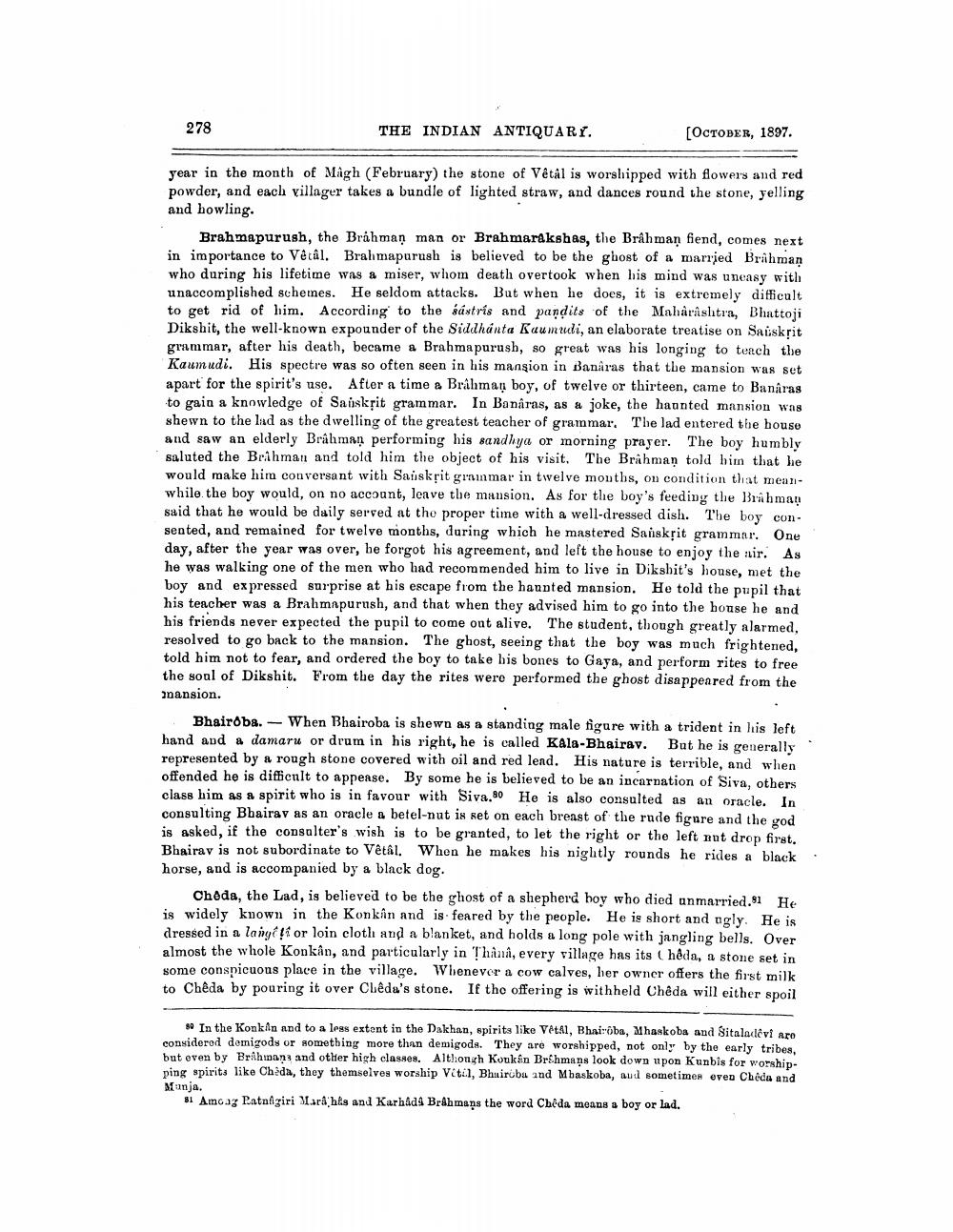________________
278
THE INDIAN ANTIQUARI.
(OCTOBER, 1897.
year in the month of Magh (February) the stone of Vêtál is worshipped with flowers and red powder, and each villager takes a bundle of lighted straw, and dances round the stone, yelling and howling
Brahmapurush, the Brahman man or Brahmarakshas, the Brahman fiend, comes next in importance to Vêtål. Brahmapurush is believed to be the ghost of a marrjed Brahman who during his lifetime was a miser, whom death overtook when his mind was uneasy with unaccomplished schemes. He seldom attacks. But when he does, it is extremely difficult to get rid of him. According to the sástrís and pandits of the Maharashtra, Bhattoji Dikshit, the well-known expounder of the Siddhanta Kuumuuli, an elaborate treatise on Sanskrit grammar, after his death, became a Brahmapurush, so great was his longing to teach the Kaumudi. His spectre was so often seen in his mansion in Banaras that the mansion was set apart for the spirit's use. After a time a Brahman boy, of twelve or thirteen, came to Banaras to gain a knowledge of Sanskrit grammar. In Banaras, as a joke, the haunted mansion was shewn to the lad as the dwelling of the greatest teacher of grammar. The lad entered the house and saw an elderly Brâhman performing his sandhya or morning prayer. The boy humbly saluted the Brahman and told him the object of his visit, The Brahman told him that he would make him conversant with Sauskpit ginimar in twelve months, on condition that means while the boy would, on no account, leave the mansion. As for the boy's feeding the Brahman said that he would be daily served at the proper time with a well-dressed dish. The boy consented, and remained for twelve months, during which he mastered Sanskrit grammar. One day, after the year was over, he forgot his agreement, and left the house to enjoy the nir. As he was walking one of the men who had recommended him to live in Dikshit's house, met the boy and expressed surprise at his escape from the haunted mansion. He told the pupil that his teacher was a Brahmapurush, and that when they advised him to go into the house he and his friends never expected the pupil to come out alive. The student, though greatly alarmed, resolved to go back to the mansion. The ghost, seeing that the boy was much frightened, told him not to fear, and ordered the boy to take his bones to Gaya, and perform rites to free the soul of Dikshit. From the day the rites were performed the ghost disappeared from the pansion.
Bhairóba. - When Bhairoba is shewn as a standing male figure with a trident in his left hand and a damaru or drum in his right, he is called Kala-Bhairav. But he is generally represented by a rough stone covered with oil and red lend. His nature is terrible, and when offended he is difficult to appease. By some he is believed to be an incarnation of Siva, others class him as a spirit who is in favour with Siva. He is also consulted as an oracle. In consulting Bhairav as an oracle a betel nut is set on each breast of the rude figure and the god is asked, if the consulter's wish is to be granted, to let the right or the left ant drop first. Bhairav is not subordinate to Vêtîl. When he makes his nightly rounds he rides a black horse, and is accompanied by a black dog.
Choda, the Lad, is believed to be the ghost of a shepherd hoy who died unmarried.91 He is widely known in the Konkan and is feared by the people. He is short and ugly. He is dressed in a langt or loin cloth and a blanket, and holds a long pole with jangling bells. Over almost the whole Konkan, and particularly in Thani, every village has its ( hoda, a stone set in some conspicuous place in the village. Whenever a cow calves, her owner offers the first milk to Chêda by pouring it over Chêda's stone. If the offering is withheld Chêda will either spoil
.
So In the KonkAn and to a less extent in the Dakhan, spirits like V AI, Bhairoba, Mhaskoba and Sitala levi Aro considerod demigods or something more than demigods. They are worshipped, not only by the early tribes, but oven by Brahmar and other high classes. Although Koukan Brehmaņs look down upon Kunbis for worshipping spirits like Chida, they themselves worship Viti), Bhuirúba and Maskoba, aud sometimes oven Choda and Manja.
#1 Amcaz Ratnagiri Marahls and Karhádi Brahmans the word Cheda moans a boy or lad.




